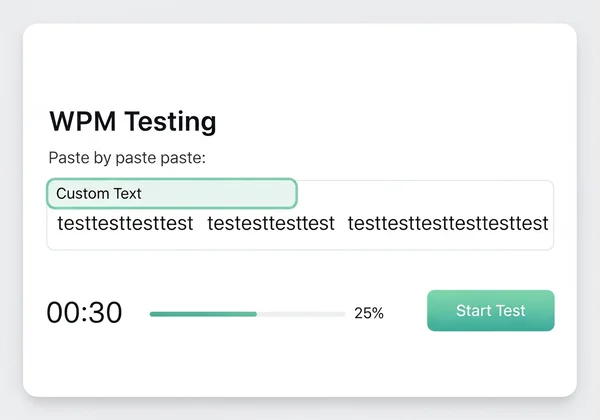Break Your Typing Speed Plateau with WPM Test: Diagnostic Guide & Drills
You’ve been practicing for weeks, maybe even months. Your words per minute (WPM) score shot up at first, but now it’s stuck. Whether you’re hovering at 40, 50, or even 70 WPM, that number just won’t budge. This is the dreaded typing speed plateau, a common but incredibly frustrating barrier for students, professionals, and enthusiasts alike. You might be wondering, how can I test my typing speed and accuracy to find the root of the problem? The good news is that plateaus aren't permanent walls; they are signals that your current practice methods need an upgrade.
This guide is your diagnostic toolkit. We will break down the common reasons your progress has stalled and provide targeted drills to help you shatter that plateau. It’s time to stop typing harder and start typing smarter. Your journey to faster, more efficient typing begins with understanding why you’re stuck. Let's diagnose the issue and get your WPM climbing again with a free WPM test.

Why Are You Stuck? Common Typing Plateaus & Their Causes
Hitting a plateau feels like running into an invisible wall. The first step to breaking through it is identifying what the wall is made of. Most typists get stuck not because they’ve reached their physical limit, but because of underlying issues in their technique. Let's explore the most common culprits.

The Accuracy Trap: Why Focusing on Speed Slows You Down
It seems counterintuitive, but trying to type faster is often what keeps you slow. When you prioritize raw speed over precision, you make more mistakes. Each error requires you to hit the backspace key, disrupting your rhythm and wasting precious seconds. This constant stop-and-go pattern creates a cycle of inefficiency that solidifies a WPM ceiling. True speed is a byproduct of effortless accuracy. Until you can type a sentence without errors, pushing for more speed will only reinforce bad habits.
Inconsistent Rhythm & Pacing: Breaking the Flow of Typing
Expert typists move their fingers with a steady, consistent cadence, much like a musician playing an instrument. Many who hit a plateau type in bursts—speeding through easy words and stumbling over difficult ones. This jerky, uneven pacing breaks your mental and physical flow. An inconsistent rhythm makes typing more mentally taxing and prevents you from building the muscle memory needed for fluid, high-speed performance. Without a smooth rhythm, your fingers are constantly playing catch-up, which effectively caps your potential WPM.
Finger Weakness, Imbalance, or Improper Placement
Are you still relying on your dominant fingers? Many typists subconsciously overuse their index and middle fingers, leaving their pinky and ring fingers underdeveloped. This imbalance creates a bottleneck, as certain letters (like P, Q, A, and Z) become awkward and slow to press. Furthermore, if your hands don't consistently return to the "home row" (ASDF JKL;), your fingers have to travel farther for each keystroke, adding milliseconds to every word and sabotaging your overall typing efficiency.
Over-reliance on Visual Cues: Still Looking at the Keyboard?
If you find yourself glancing down at your keyboard, even for a split second, you haven't mastered touch typing. This habit is the single biggest barrier to breaking past intermediate speeds. Looking away from the screen to find a key breaks your concentration and disrupts the connection between your brain and your fingers. True typing mastery happens when the process becomes automatic, allowing your fingers to type what you're thinking without conscious effort. This can only be achieved when your eyes stay on the screen.
Targeted Drills to Boost Your WPM Beyond 50 or 60
Once you’ve identified your potential weaknesses, you can use targeted exercises to address them directly. Random practice will only get you so far. These specific drills are designed to rebuild your technique from the ground up and push you past your current limits. To track your progress, start with a typing speed test to set your baseline.

Accuracy-First Drills: Mastering Precision Before Speed
Your ultimate goal here is pinpoint accuracy—even if it means slowing down initially. Focus on hitting every single key correctly. If you make a mistake, stop, and retype the word correctly before moving on. A great way to do this is to use a typing test and aim for a perfect score, ignoring the WPM result for now. Consciously slow down until you stop making errors. This drill retrains your muscle memory for correctness, which forms the foundation for sustainable speed.
Rhythm & Pacing Exercises: Building a Consistent Typing Flow
To develop a steady rhythm, try typing along with a metronome. Set it to a slow, comfortable pace and type one character for every beat. As you get comfortable, gradually increase the tempo. This forces you to eliminate those quick bursts and slow stumbles, smoothing out your overall cadence. You’ll find that a consistent, even flow—even at a slower pace—often results in a higher WPM score than erratic, rushed typing.
Finger Strength & Dexterity Warm-ups for All Fingers
Your fingers, especially the pinkies, need dedicated training. Before a practice session, do simple finger stretches. Then, perform drills that target specific, underused fingers. Practice typing patterns like "plplpl," "qaqaqa," or "azazaz" repeatedly. This builds strength and agility in all your fingers, ensuring no single digit is holding back your potential. Stronger fingers lead to more confident and faster keystrokes.
Blind Typing Challenges: Forcing Touch Typing Habits
It’s time to break the habit of looking at your keyboard for good. If you need to, cover your hands with a small cloth or box so you physically cannot see the keys. This will be difficult and your speed will plummet at first, but it is the only way to force your brain to rely on muscle memory. Start with simple words and home row sentences. This forces you to learn the keyboard by feel, which is the essence of true touch typing.
Leveraging the WPM Test Site's Custom Text for Focused Practice
This is where you can turn our platform into your personal typing gym. Instead of using random text, our platform allows you to paste your own content. Found a word that always trips you up? Create a drill by repeating it 20 times. Need to practice common letter combinations like "th," "ing," or "tion"? Paste them into the custom text box. For professionals, you can practice with industry-specific jargon or code snippets. This feature allows for deliberate practice, targeting your exact weaknesses for the most efficient improvement. Give our custom text practice a try to see the difference.

Your Path to Typing Mastery Starts Now: Consistency is Key
Breaking through a typing speed plateau isn’t about a single magic trick; it’s about a strategic shift in your practice. By diagnosing your technical flaws and applying targeted drills with patience and consistency, you can systematically dismantle the barriers holding you back. Remember to prioritize accuracy, cultivate a steady rhythm, and trust the touch-typing process.
Your keyboard is a tool, and with the right training, you can operate it with incredible speed and precision. Use the insights from this guide to inform your practice, and don't forget to regularly check your WPM to measure your progress. Your next WPM record is waiting for you.
Frequently Asked Questions About Typing Speed Plateaus
What is considered a good WPM score to aim for?
A "good" WPM score is relative to your goals. For casual use, 40-50 WPM is considered average. For professional roles that involve heavy typing, such as administrative or programming jobs, aiming for 60-80 WPM is a great target. Competitive typists often exceed 100 WPM. The key is to aim for steady improvement rather than a single magic number.
How can I consistently improve my typing speed after hitting a plateau?
Consistent improvement after a plateau requires deliberate practice. Instead of just typing, focus on one specific weakness at a time. Use the drills mentioned above, such as accuracy-first exercises or rhythm training. Use a tool that provides detailed feedback on your speed and accuracy, so you can track whether your new strategies are working.
Is it better to focus on speed or accuracy first when practicing?
Accuracy should always be your primary focus. Speed built on a foundation of errors is inefficient and unsustainable. By focusing on typing perfectly at a slower pace, you build clean muscle memory. Once you can type accurately without thinking, speed will naturally follow as your confidence and fluidity increase.
How long does it typically take to break through a typing plateau?
The time it takes varies from person to person and depends on the consistency of your practice. It could take a few days of focused effort to correct a minor habit or a few weeks to rebuild a foundational skill like touch typing. The key is consistent, targeted practice. Keep tracking your progress with a reliable typing wpm test to stay motivated.